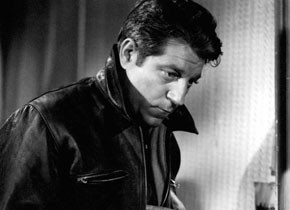Noir | Polar
The French Crime Thriller 1930-1960
August 28 to October 15, 2015
The consolidation of the French crime film coincides with the introduction of sound in cinema; its reorientation in 1960 with the onslaught of the Nouvelle Vague. In between lies a "classic" period, itself marked by numerous mutations analogous to the transformation of the nation. The film policier – the crime thriller in all its forms – serves as a key to the country's self-conception and, at the same time, as a popular product for exporting l’esprit français. It is condensed in film titles such as Rififi or Diabolique, which have since become catchphrases the world over; it is inextricably linked to stars like Jean Gabin, Michel Simon or Simone Signoret; and it has exerted a strong attraction on the quintessential French directors, from Jean Renoir and Julien Duvivier through Henri-Georges Clouzot and Jacques Becker to Jean-Pierre Melville.
The two terms of the title – Noir | Polar – also describe a development in reception. In the post-war era, film noir began to be used as a label by French critics for a type of U.S. cinema whose traumatic "blackness" reflected contemporary social neuroses. Originally, however, the term was coined for French crime films between 1935 and 1939. During the cultural struggles of the Popular Front period, the political right attacked several masterpieces of poetic realism as being "black" and "defeatist": Renoir's La Bête humaine, Duvivier's Pépé le Moko, Marcel Carné's Quai des Brumes and Le Jour se lève and Pierre Chenal's Le Dernier Tournant, the first adaptation of The Postman Always Rings Twice. Their pessimism was equated with demoralization; the latter seemingly confirmed by France's passivity in the face of the German Occupation in the spring of 1940. The word polar on the other hand – a colloquial abbreviation of film policier – is a retroactive stamp, deriving from a generation of leftist crime novelists and critics in the 1970s who began to emphasize the subversive socio-critical tradition of French crime stories.
French cinema had been preoccupied with the criminal world as early as the 1910s, but it was the introduction of sound that stabilized the film policier as a genre, fueled by audible stimuli such as gunfire or the naturalistic tone of gangster speak or argot. Around 1930, crime fiction also began to emancipate itself from its 19th century models. In prolific Belgian writer Georges Simenon the 20th century found its Balzac of the thriller genre, and two ingenious Maigret adaptations from 1932-33 became decisive for the polar – Duvivier's La Tête d'un homme and the shadow play La Nuit du Carrefour by Jean Renoir, who had already lit the noir fuse with his La Chienne in 1931. The influence of Weimar city films also finds its way into the crime genre, with Anatole Litvak's marvellous Cœur de lilas (1932) and Pierre Chenal's La Rue sans nom (1934) serving as exemplary cases. This is the birth of poetic realism, the movement that dominated the years of the Popular Front and its downfall with its lyrically aestheticized (and usually studio shot) examinations of life in times of crisis. These fatalistic studies of individual rebellion against the system turned Jean Gabin into a legend. Gabin is also the veritable star of the retrospective, ahead of even the incomparable Michel Simon and other exceptional players such as Harry Baur, Louis Jouvet, Simone Signoret or Danielle Darrieux, and even the most important directors.
Of the latter, Renoir and Duvivier (like Gabin) enter into Hollywood exile with the "black years" of the German occupation, and a new generation succeeds them. At first, Jacques Becker and Henri-Georges Clouzot pair their dark views of society with elements of American "screwball" humour. However, Clouzot's pitch black study of informers, Le Corbeau (1943), turns into a scandal, while Henri Decoin's Simenon adaptation L'Homme de Londres translates the national crisis of conscience into a black mood painting. The Liberation brings little change to the atmosphere: Decoin's 1947 masterpiece Non coupable seamlessly conjures up the shame and guilt of the Grande Nation, and Clouzot (who as a “collaborator” had until recently been blacklisted) celebrates a major comeback with the entanglement thriller Quai des Orfèvres. With Panique and La Foire aux Chimères the returning Duvivier and Chenal translate social disappointment into baroque dances of death. And in parallel with U.S. film noir, Yves Allégret transforms poetic realism into full-blown nihilism in the late 1940s – making a star of Simone Signoret in the process.
From 1950 onwards, a new generation of stars such as Lino Ventura or Jeanne Moreau appear on the margins of the genre. Meanwhile, the political "sedation" of the country inscribes itself in many plots. Becker’s key work, Touchez pas au Grisbi (1954), narrates the gentrification of the gangsters and establishes the second iconic figure for Gabin, no longer aimed automatically against society: This film and Decoin's Simenon adaptation La Vérité sur Bébé Donge see the "old" actor at the peak of his craft. As a counterpoint to the suffocation of the "fat years," Becker perfected a cool, laconic thriller style, picked up by Jules Dassin's clockwork-like tale of a burglary, Rififi, and pursued to the point of abstraction by auteurs like Melville and Robert Bresson. Becker's final film truly marks an endpoint: In Le Trou (1960) he merges documentary precision with suspense, the classical with the modern. Melville will draw further consequences from this film (which he loved) and its writer José Giovanni will also shape the next phase of the polar. At the time of its release, however, coming two days after A bout de souffle, Le Trou is already outshone by the New Wave. The second part of the retrospective will examine this upheaval and its consequences in autumn 2016.
The retrospective is kindly supported by the Institut français (Paris). It features 39 works by 17 filmmakers, three of whom – Jacques Becker, Henri Decoin and Sacha Guitry – will be the subject of special introductions.
